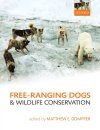About this book
Dogs are the world's most common and widespread carnivores and are nearly ubiquitous across the globe. The vast majority of these dogs, whether owned or un-owned, pure-bred or stray, spend a large portion of their life as unconfined, free-roaming animals, persisting at the interface of human and wildlife communities. Their numbers are particularly large throughout the developing world, where veterinary care and population control are often minimal and human populations are burgeoning.
Free-Ranging Dogs and Wildlife Conservation brings together the world's experts to provide a comprehensive, unifying, and accessible review of the effects of dogs on native wildlife species. With an emphasis on addressing how free-ranging dogs may influence wildlife management and native species of conservation concern, chapters address themes such as the global history and size of dog populations, dogs as predators, competitors, and prey of wildlife, the use of dogs as hunting companions, the role of dogs in maintaining diseases of wildlife, and the potential for dogs to hybridize with wild canid species. In addition, the potential role of dogs as mediators of conservation conflict is assessed, including the role of dogs as livestock guardians, the potential for dogs to aid researchers in locating rare wildlife species of conservation interest, and the importance of recognizing that some populations of dogs such as dingoes have a long history of genetic isolation and are themselves important conservation concerns. A common theme woven throughout Free-Ranging Dogs and Wildlife Conservation is the potential for dogs to mediate how humans interact with wildlife and the recognition that the success of wildlife conservation and management efforts are often underpinned by understanding and addressing the potential roles of free-ranging dogs in diverse natural ecosystems.
Free-Ranging Dogs and Wildlife Conservation is aimed at professional wildlife and conservation ecologists, managers, graduate students, and researchers with an interest in human-dog-wildlife interactions. It will also be of relevance and use to dog welfare researchers, veterinary scientists, disease ecologists, and readers with an interest in the interface of domestic animals and wildlife.
Contents
Luigi Boitani: Foreword
Matthew E. Gompper: Introduction: Outlining the Ecological Influences of a Subsidized, Domesticated Predator
1: Matthew E. Gompper: The Dog-Human-Wildlife Interface: Assessing the Scope of the Problem
2: Euan G. Ritchie, Mike Letnic, Christopher R. Dickman and Abi Tamim Vanak: Dogs as Predators and Trophic Regulators
3: Abi Tamim Vanak, Christopher R. Dickman, Eduardo A. Silva-Rodriguez, James R. A. Butler and Euan G. Ritchie: Top-dogs and Under-dogs: Competition between Dogs and Sympatric Carnivores
4: Michael A. Weston and Theodore Stankowich: Dogs as Agents of Disturbance
5: James R.A. Butler, John D.C. Linnell, Damian Morrant, Vidya Athreya, Nicolas Lescureux and Adam Mckeown: Dog Eat Dog, Cat Eat Dog: Social-ecological Dimensions and Implications of Dog Predation by Wild Carnivores
6: Darryn Knobel, James R. A. Butler, Tiziana Lembo, Rob Critchlow and Matthew E. Gompper: Dogs, Disease, and Wildlife
7: Jennifer A. Leonard, Jorge Echegaray, Ettore Randi and Carles Vilà: Impact of Hybridization with Domestic Dogs on the Conservation of Wild Canids
8: Ryan H. Boyko and Adam R. Boyko: Dog Conservation and the Population Genetic Structure of Dogs
9: Kurt VerCauteren, Michael Lavelle, Thomas M. Gehring, Jean-Marc Landry and Laurie Marker: Dogs as Mediators of Conservation Conflicts
10: Deborah A. (Smith) Woollett, Aimee Hurt and Ngaio Richards: The Current and Future Roles of Free-ranging Detection Dogs in Conservation Efforts
11: Jeremy Koster and Andrew Noss: Hunting Dogs and the Extraction of Wildlife as a Resource
12: Kelly K. Miller, Euan G. Ritchie and Michael A. Weston: The Human Dimensions of Dog-Wildlife Interactions
Customer Reviews
Biography
Dr Matthew Gompper is a Professor of Mammalogy in the School of Natural Resources at the University of Missouri, USA, and also directs the university's Program in Conservation Biology. His research focuses on the interactions of free-ranging dogs and wildlife, as well as the ecology and conservation of diverse species of mammalian carnivores that range in size from weasels and martens to bears and tigers. He and his students have worked on these issues across the globe, including in India, Nepal, Brazil, Panama, Mexico and the North-eastern and Mid-western United States.


































